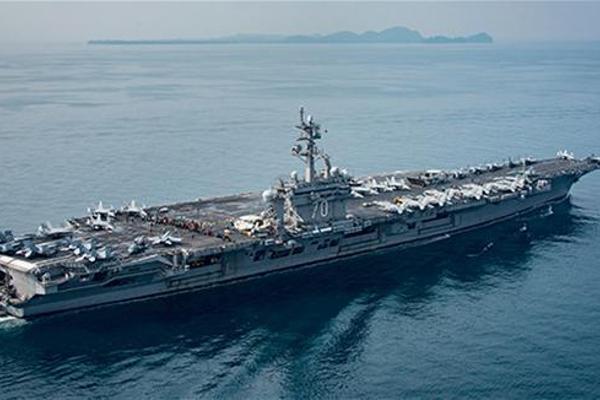US warship in west Pacific for navy drills with Japan
TOKYO - Agence France-Presse


The exercises -- also involving a U.S. guided-missile cruiser and guided-missile destroyer -- are being held in the Philippine Sea, the navy said, as the naval strike group “continued its northern transit in the Western Pacific.”
Confusion has clouded the carrier group’s whereabouts in recent days after President Donald Trump suggested the “armada” was steaming towards North Korea when in fact it was sent towards Australia.
On April 22 U.S. Vice President Mike Pence said in Sydney the strike group would arrive in the Sea of Japan (East Sea) “in a matter of days.”
Pence has vowed an “overwhelming and effective” response to any North Korean attack as fears grow it may be preparing for another nuclear test.
Pyongyang reacted defiantly.
State newspaper Minju Joson quoted what it called military sources as saying Washington plans to station “several nuclear carrier task forces” off the Korean peninsula this week.
“The army of the DPRK [North Korea] already declared it will deal merciless destructive blows at the enemies so that they would not come back to life again should they make reckless provocation,” the paper said.
The Carl Vinson carrier strike group and the Japanese navy “commenced an at-sea bilateral exercise in the Philippine Sea” on April 23, the U.S. Navy posted on its Facebook page.
The joint drill is designed to “ensure maritime forces remain ready to defend the region when called upon,” it said.
“Seeing the threats we are facing now, it is no surprise that Japan and the United States conduct joint exercises,” Toshimitsu Motegi, a senior ruling party lawmaker, told Japan’s NHK public broadcaster, adding the exercises would send a “strong message.”
The Carl Vinson drills, expected to last several days, involve two Japanese warships, Japan’s defense ministry said.
Pence, during a regional tour last week that ended in Australia, and other U.S. officials have warned that “all options are on the table” to curb the North’s nuclear ambitions.
Pence and Trump have also renewed calls for China to use its influence to bring Pyongyang to heel.
The North has ramped up its rhetoric in recent weeks, threatening to hit back against any provocation.
It has also renewed threats against regional U.S. allies, including Japan and South Korea, which both host large American military contingents.
Even Australia has been cautioned.
“If Australia persists in following the U.S.’s moves to isolate and stifle North Korea... this will be a suicidal act,” a North Korean foreign ministry spokesman said after Australian Foreign Minister Julie Bishop called the nation a “serious threat.”
Bishop responded April 23 that the North “should invest in the welfare of its long-suffering citizens, rather than weapons of mass destruction.”
Washington is sending a senior envoy on the nuclear standoff with North Korea to Tokyo this week for talks with his Japanese and South Korean counterparts.
